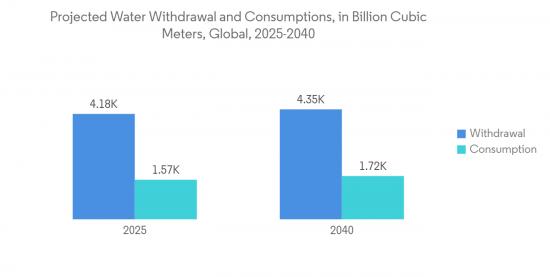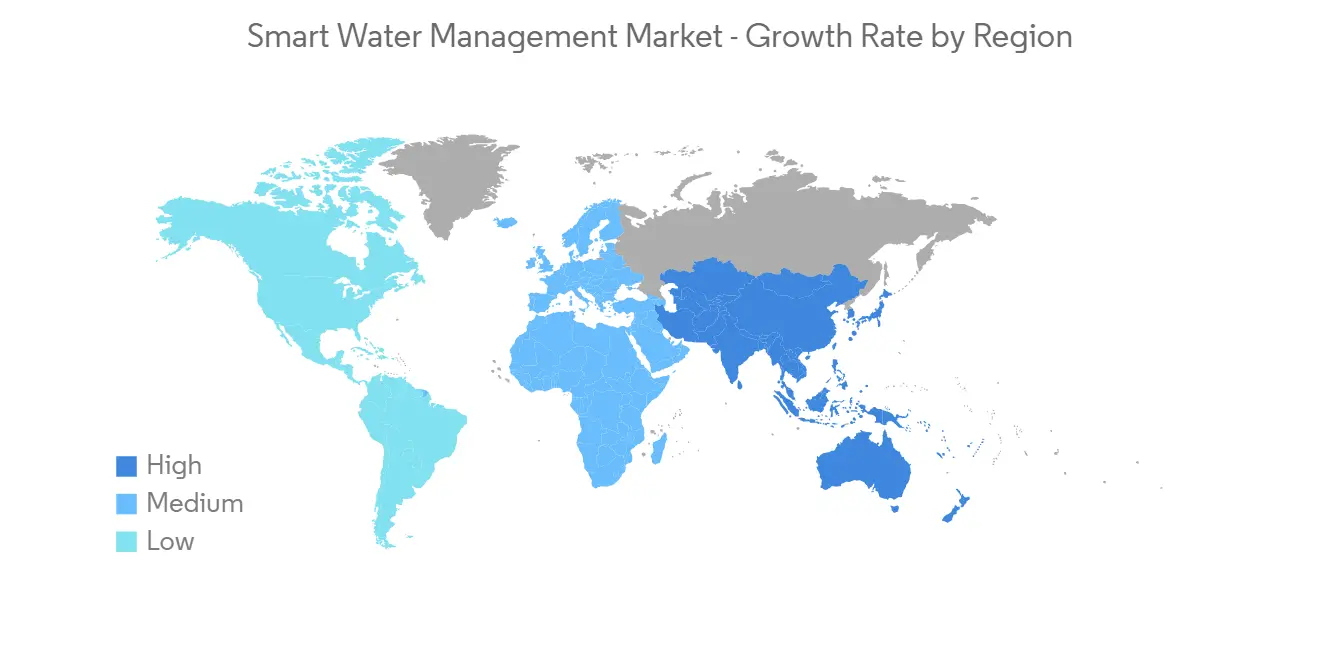 |
市場調査レポート
商品コード
1331265
スマート水管理市場の規模・シェア分析- 成長動向と予測(2023年~2028年)Smart Water Management Market Size & Share Analysis - Growth Trends & Forecasts (2023 - 2028) |
||||||
● お客様のご希望に応じて、既存データの加工や未掲載情報(例:国別セグメント)の追加などの対応が可能です。 詳細はお問い合わせください。
| スマート水管理市場の規模・シェア分析- 成長動向と予測(2023年~2028年) |
|
出版日: 2023年08月08日
発行: Mordor Intelligence
ページ情報: 英文 152 Pages
納期: 2~3営業日
|
- 全表示
- 概要
- 目次
スマート水管理市場規模は、2023年の160億8,000万米ドルから2028年には308億米ドルに成長し、予測期間(2023-2028年)のCAGRは13.89%になると予測されます。
近年、人口増加と都市化に伴い、世界の水需要と老朽化したインフラ維持のコスト負担に対処する必要性が、スマート水管理市場の主な成長要因となっています。
主なハイライト
- スマート水管理(SWM)は、情報通信技術(ICT)とリアルタイムのデータと対応を利用するもので、水管理の課題解決に不可欠な要素です。水管理におけるスマートシステムの潜在的応用範囲は広大で、水質、水量、効率的な灌漑、漏水、圧力と流量、洪水、干ばつなどのソリューションが含まれます。
- 公共ネットワークにおける水損失を検出するためのスマートデータ駆動型手法が普及しつつあります。こうしたソリューションは、モノのインターネット(IoT)と人工知能(AI)技術の応用に基づいています。パレスチナでは、UNDP/PAPPのアクセラレーター・ラボが、有望な新興企業であるフローレス(FlowLess)と提携し、カスタマイズされたウェブ・プラットフォームに支えられたIoTとAIを利用して、地元で開発されたコスト効率の高い水損失検出のためのスマートシステムをテストしました。
- 水インフラのコストは、水循環全体とその主な用途すべてについて評価する必要があります。2030年が近づくにつれ、新たに建設されたインフラの運用コストは、未供給のまま残っている人々に対応するために必要な年間資本コストを上回る可能性があります。請求精度の向上と相まって、スマート水道メーターへの投資における短期的な問題は、初期資本支出が高くなることを浮き彫りにしています。伝統的な水管理ユーザーは、より新しく先進的な方法への切り替えに消極的です。ほとんどの新興国では、インフラとトレーニングの初期費用が高く、市場の成長を妨げています。
- COVID-19パンデミック後、欧州諸国は水損失ソリューションへの投資に注力しています。欧州連合(EU)は円滑な移行を支援するため、研究と技術革新に投資しています。市民の79%は、気候変動への取り組みが欧州企業の競争力を高めるイノベーションにつながる可能性があることに同意し、70%は、水を利用した活動が市民にプラスの影響を与える可能性があることに同意しています。
スマート水管理市場の動向
水管理ニーズの高まりが市場を牽引
- UN-Waterによると、2025年までに18億人が絶対的な水不足の国や地域に住む可能性があります。新興諸国は、水不足、洪水、水質悪化の影響を最も受けています。各国は、国連の持続可能な開発目標「2030アジェンダ」に向けて取り組んでいます。水の目標は、17の持続可能な開発目標に含まれています。
- 世界水会議によると、2025年までに40億人近くが水不足に直面すると予想されています。汚染された飲料水は公衆衛生に重大な脅威をもたらし、破綻したダムや時代遅れの水インフラもまた人々に害を及ぼしています。長く続く干ばつと配水システムの故障は、水供給に対するもうひとつの課題です。このような場合、時代遅れの水資産管理は効率を制限し、人々の生活を危険にさらします。
- 世界的に淡水が不足する中、政府機関は水管理政策を優先課題としています。国連は、基本的な水へのアクセスを、30分以内に水源を確保できることと定義しています。最近では、持続可能な開発目標に水の保全が掲げられています。
- その一方で、ESRI GIS社の調査によると、給水ポイントの25%が最初の4年以内に破損しており、これは大規模な故障率を示しています。異常気象は、水不足やインフラの故障と相まって、特に南アジアの大手水道会社を直撃する要因となっています。例えば、水道事業者であるSADAは、マレーシアのケダ州で200万人以上に一貫した中断のない水供給を供給する問題を目の当たりにしています。

アジア太平洋地域が最速の成長を記録する見込み
- アジア太平洋には21億人以上の都市住民が住んでおり、2050年までに3分の2以上が都市に住むと推定されています。この地域は、インド(配水量全体の60%近くが収入減)やシンガポールのように、無収水量(NRW)の損失が大きい国々で構成されています。こうした数字は、水管理の必要性を示すとともに、この地域における市場成長の可能性を示しています。
- また、この地域では、接続デバイスの増加や水管理へのIoT技術の採用により、IoTプラットフォームへの需要が高まっています。例えば、インドの新興企業であるAgua Water Systems社は、スマート・ソリューションの助けを借りて水使用量の監視を可能にしています。このプラグアンドプレイ・システムは、人工知能(AI)を活用して水の使用量を分析し、ポンプ内の水位を測定し、配水を制御します。このプロセスでは、モーター・コントローラー、超音波センサー、流量センサーなど、複数のスマート・ワイヤレス・デバイスが使用されます。
- 消費者は、スマート水管理ソフトウェアやハードウェアを採用することで、住宅をアップグレードしています。この採用率は、ソフトウェアとハードウェアがより安価で手頃な価格になってきているため、急速に増加しています。
- デジタル化は、発展途上国におけるコネクテッド・テクノロジーの採用とともに、スマート水管理用システムが住宅部門で周囲と相互作用する方法を変革することによって、スマート水管理用ソリューションのすべてのアプリケーションに影響を与えています。

スマート水管理産業の概要
調査対象市場は、複数の世界プレーヤーと新興プレーヤーで構成され、かなり競争の激しい市場空間で注目を集めようと競い合っています。複数の企業がこの市場を自社製品を統合する有利な機会と見なしているため、企業集中率は予測期間中に高い成長を記録すると予想されます。さまざまな企業がこの市場で新製品や先進製品を発売しています。
- 2022年2月、タカドゥは、予知保全のためのユニバーサル・スマート・モニタリングのスペシャリストであるAsystomと提携し、水道事業の顧客に統合され強化された中央イベント/資産管理ソリューションを提供します。
- 2022年2月、ABBはABB Ability Smart Solution for Wastewaterを発表しました。このデジタルソリューションは、エネルギー消費を最低限に抑えながら、最高の運転要件を達成するという下水処理場運営者の課題を解決します。この革新的なソリューションは、アドバンスト・プロセス・コントロール(APC)と、将来の運転ニーズを予測するデジタル・ツイン・シミュレーション技術の2つの柱で構成されています。
その他の特典
- エクセル形式の市場予測(ME)シート
- 3ヶ月間のアナリスト・サポート
目次
第1章 イントロダクション
- 調査の前提と市場定義
- 調査範囲
第2章 調査手法
第3章 エグゼクティブサマリー
第4章 市場洞察
- 市場概要
- 業界の魅力度-ポーターのファイブフォース分析
- 供給企業の交渉力
- 買い手の交渉力
- 新規参入業者の脅威
- 競争企業間の敵対関係
- 代替品の脅威
- 業界バリューチェーン分析
- COVID-19の市場への影響
第5章 市場力学
- 市場促進要因
- 世界の水需要の増加を管理する必要性の高まり
- 無収水量(NRW)ロスを削減する需要の増加
- 市場抑制要因
- インフラ設置のための設備投資不足
第6章 市場セグメンテーション
- タイプ別
- ソリューション別
- 資産管理
- 配電網モニタリング
- 監視制御・データ収集(SCADA)
- メーターデータ管理(MDM)
- 分析
- その他のソリューション
- サービス別- マネージド/プロフェッショナル
- ソリューション別
- エンドユーザー別
- 住宅
- 商業
- 産業
- 地域別
- 北米
- 欧州
- アジア太平洋
- ラテンアメリカ
- 中東・アフリカ
第7章 競合情勢
- 企業プロファイル
- ABB Ltd
- IBM Corporation
- SUEZ Group
- Honeywell International Inc.
- Schneider Electric SE(+AVEVA)
- Siemens AG
- Sebata Holdings Limited
- Hitachi Ltd
- Arad Group
- TaKaDu Limited
- Sensus Inc.(Xylem Inc.)
- Itron Inc.
- i2O Water Ltd
- Huawei Technologies Co. Ltd
- Esri Geographic Information System Company
第8章 投資分析
第9章 今後の動向
The Smart Water Management Market size is expected to grow from USD 16.08 billion in 2023 to USD 30.80 billion by 2028, at a CAGR of 13.89% during the forecast period (2023-2028).
In recent years, owing to increasing population and urbanization, the global demand for water and the need to address the cost implications of maintaining an aging infrastructure has been the major growth factors for the smart water management market.
Key Highlights
- Smart water management (SWM) uses information and communication technology (ICT) and real-time data and responses, which is an integral part of the solution for water management challenges. The potential application of smart systems in water management is vast and includes solutions for water quality, water quantity, efficient irrigation, leaks, pressure and flow, floods, droughts, and more.
- Smart data-driven methods for detecting water losses in public networks are becoming popular. Such solutions are based on the application of the internet of things (IoT) and artificial intelligence (AI) techniques. In the State of Palestine, the UNDP/PAPP's Accelerator Lab partnered with a promising start-up company, FlowLess, to test a locally developed and cost-efficient smart system for detecting water losses using IoT and AI, supported by a customized web platform.
- Water infrastructure costs need to be assessed across the full water cycle and for all its major uses. As 2030 approaches, the costs of operating a new infrastructure built may exceed the annual capital cost requirements to meet those remaining unserved. When coupled with increased billing accuracy, the short-term issues in investing in smart water metering highlight a higher initial capital outlay. Traditional water management users are reluctant to switch to newer and advanced methods. The high initial cost of infrastructure and training prevails in most developing nations, hindering the market's growth.
- Post-COVID-19 pandemic, European countries are focused on investing in water loss solutions. The European Union has invested in research and innovation to support a smooth transition. 79% of citizens agree that tackling climate change may lead to innovation that may make European companies more competitive, and 70% agree that water-based activity may positively affect citizens.
Smart Water Management Market Trends
Growing Need for Water Management to Drive the Market
- According to UN-Water, by 2025, 1.8 billion people may be living in countries or regions with absolute water scarcity. Developing countries are most affected by water shortages, flooding, and poor water quality. Countries are working toward the United Nations' 2030 Agenda for sustainable development goals. Water targets are included across the 17 sustainable development Goals.
- According to the World Water Council, nearly four billion people are expected to face water stress by 2025. Contaminated drinking water poses a significant threat to public health, and failing dams and outdated water infrastructure are also harming people. Long-lasting droughts and failing water distribution systems constitute another set of challenges to the water supply. Outdated water asset management, in such cases, restricts efficiency and puts people's lives at risk.
- With the scarcity of fresh water globally, governing bodies have made water management policies a priority agenda. The United Nations defines basic water access as having an improved water source within a 30-minute collection time. Recently, water conservation has been promoted to its sustainable development goals.
- On the other hand, ESRI GIS Company's study suggests that 25% of water points break within the first four years, indicative of a massive failure rate. Extreme weather events, coupled with water scarcity and failing infrastructure, are contributing factors hitting major water companies, especially in South Asia. For instance, SADA, a water utility, has witnessed issues supplying a consistent and uninterrupted water supply to over two million people in Kedah, Malaysia.

Asia-Pacific is Expected to Register the Fastest Growth
- Asia-Pacific is home to more than 2.1 billion urban residents, with over two-thirds estimated to live in cities by 2050. The region comprises countries with substantial non-revenue water (NRW) losses, like India (with almost 60% of revenue losses from the total water distributed) and Singapore. Such figures signify the need for water management and indicate the potential for market growth in the region.
- The region is also witnessing demand for IoT platforms due to the growing number of connected devices and the adoption of IoT technologies for water management. For instance, Agua Water Systems, an Indian start-up, enables water usage monitoring with the help of smart solutions. The plug-and-play system utilizes artificial intelligence (AI) to analyze water usage, measure the water level in the pump, and control water distribution. Several smart wireless devices, such as motor controllers, ultrasonic sensors, and flow sensors, are used in the process.
- Consumers are upgrading their residences by adopting smart water management software and hardware. This adoption rate is rapidly increasing as software and hardware are becoming cheaper and more affordable.
- Digitization, along with the adoption of connected technologies in developing nations, is impacting all applications of solutions for smart water management by revolutionizing the way the systems for smart water management interact with the surroundings in the residential sector.

Smart Water Management Industry Overview
The market studied comprises several global players and emerging new players vying for attention in a fairly-contested market space. The firm concentration ratio is expected to record higher growth during the forecast period because several firms consider this market a lucrative opportunity to consolidate their offerings. Various companies are launching new and advanced products in the market.
- In February 2022, Takadu partnered with Asystom, a specialist in universal smart monitoring for predictive maintenance, to provide water utility customers with an integrated and enhanced central event/asset management solution.
- In February 2022, ABB introduced the ABB Ability Smart Solution for Wastewater. This digital solution solves wastewater treatment plant operators' challenges in achieving both the lowest energy consumption and the highest operational requirements. The innovative solution comprises two main pillars, advanced process control (APC) and digital twin and simulation technology to forecast future operational needs.
Additional Benefits:
- The market estimate (ME) sheet in Excel format
- 3 months of analyst support
TABLE OF CONTENTS
1 INTRODUCTION
- 1.1 Study Assumptions and Market Definition
- 1.2 Scope of the Study
2 RESEARCH METHODOLOGY
3 EXECUTIVE SUMMARY
4 MARKET INSIGHTS
- 4.1 Market Overview
- 4.2 Industry Attractiveness - Porter's Five Forces Analysis
- 4.2.1 Bargaining Power of Suppliers
- 4.2.2 Bargaining Power of Buyers
- 4.2.3 Threat of New Entrants
- 4.2.4 Intensity of Competitive Rivalry
- 4.2.5 Threat of Substitute Products and Services
- 4.3 Industry Value Chain Analysis
- 4.4 Impact of COVID-19 on the Market
5 MARKET DYNAMICS
- 5.1 Market Drivers
- 5.1.1 Growing Need to Manage the Increasing Global Demand for Water
- 5.1.2 Increasing Demand to Reduce Non-revenue Water (NRW) Losses
- 5.2 Market Restraints
- 5.2.1 Lack of Capital Investments to Install Infrastructure
6 MARKET SEGMENTATION
- 6.1 By Type
- 6.1.1 By Solution
- 6.1.1.1 Asset Management
- 6.1.1.2 Distribution Network Monitoring
- 6.1.1.3 Supervisory Control and Data Acquisition (SCADA)
- 6.1.1.4 Meter Data Management (MDM)
- 6.1.1.5 Analytics
- 6.1.1.6 Other Solutions
- 6.1.2 By Services - Managed/Professional
- 6.1.1 By Solution
- 6.2 By End User
- 6.2.1 Residential
- 6.2.2 Commercial
- 6.2.3 Industrial
- 6.3 By Geography
- 6.3.1 North America
- 6.3.2 Europe
- 6.3.3 Asia-Pacific
- 6.3.4 Latin America
- 6.3.5 Middle East and Africa
7 COMPETITIVE LANDSCAPE
- 7.1 Company Profiles
- 7.1.1 ABB Ltd
- 7.1.2 IBM Corporation
- 7.1.3 SUEZ Group
- 7.1.4 Honeywell International Inc.
- 7.1.5 Schneider Electric SE (+AVEVA)
- 7.1.6 Siemens AG
- 7.1.7 Sebata Holdings Limited
- 7.1.8 Hitachi Ltd
- 7.1.9 Arad Group
- 7.1.10 TaKaDu Limited
- 7.1.11 Sensus Inc. (Xylem Inc.)
- 7.1.12 Itron Inc.
- 7.1.13 i2O Water Ltd
- 7.1.14 Huawei Technologies Co. Ltd
- 7.1.15 Esri Geographic Information System Company
